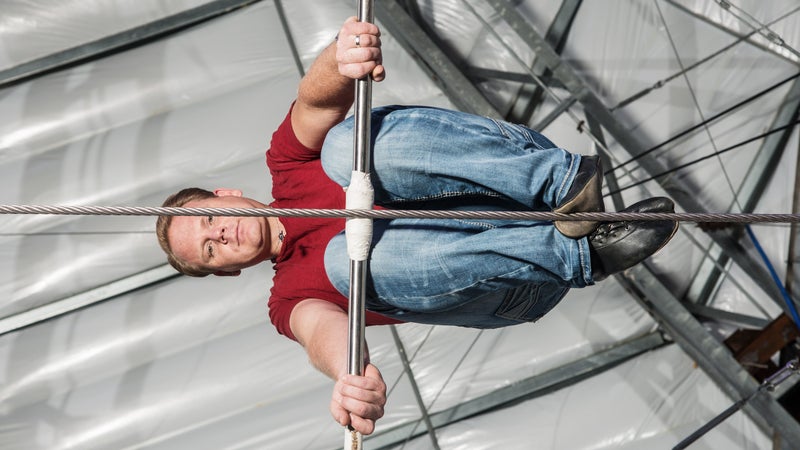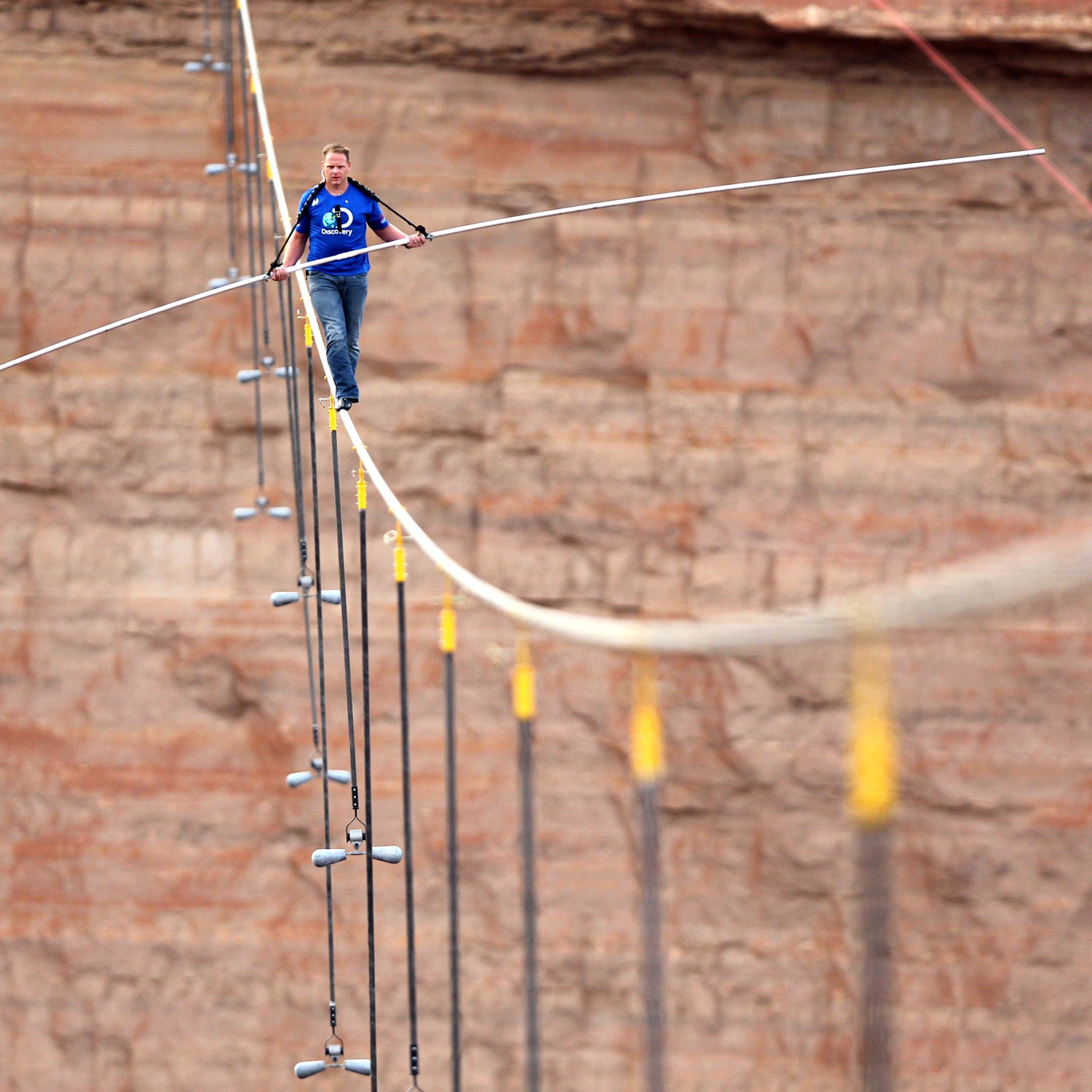Nik Wallenda is organizing the merch cart, trying to figure out the perfect configuration for selling the most T-shirts and coffee mugs stamped with his likeness. “I hate being a perfectionist,” he says.
A little perfectionism is probably a good thing in Wallenda’s line of work. In recent years, he has walked a high wire 1,400 feet (tethered, though not by choice) and crossed another 1,400-foot cable (untethered, as he prefers). Approximately 13 million people watched each of the walks on television, setting ratings records for both ABC and Discovery and making Wallenda one of the most famous daredevils of our time. Since June, though, he has kept a lower profile—anchoring two vaudevillian shows each day among the roller coasters and arcade games at the Darien Lake Amusement Park outside Buffalo, New York.
[quote]“The public is fascinated with a guy on TV that could die at any second,” Wallenda says. “Now, do they wanna see me die? I don’t think so.”[/quote]
The show is entertaining to watch. Wallenda and his wife do things like handstands on sway poles 50 feet above the floor. More important, the gig gives the 35-year-old a break from the road. Nik spends more than half the year traveling, and at Darien Lake he’s able to park his fifth-wheel camper, put a chain-link privacy fence around it, and host barbecues with his wife, Erendira, his mother, Delilah, and his kids, Yanni, Amadaos, and Evita.
But it’s been a month, and Wallenda is growing restless. He has risked his life countless times during his career, and he’s not satisfied unless he’s doing something spectacular and a little crazy. So he’s begun training for his next big live-TV special, scheduled for November 2, when he’ll walk not just one but two wires rigged 50 stories above the streets of Chicago. He’ll begin at the iconic Marina City West tower and walk a wire strung at an uphill 15-degree angle across the Chicago River to the Leo Burnett Building. Then he’ll come down to ground level, walk back to Marina City West, and cross another wire to the Marina City East tower.
“It’s gonna be cold. It’s gonna be windy,” Wallenda says over lunch. “That’s the challenge. The other walks were enjoyable, peaceful.”
Characterizing the canyon and Niagara stunts as tranquil endeavors is typical of Wallenda, who has been walking wires since he was two. His trade requires both focus and a sustained application of core strength, but his greatest skill is in making the crowd see uncertainty where, he says, there is none. “At this point, the physical part comes natural,”he says.“It comes too easy, actually.”
His confidence is a little surprising when you consider that a dozen Wallendas over eight generations have fallen from their wires. Seven have died. There’s a horrifying YouTube video of Nik’s great-grandfather Karl, then 72, falling to his death in 1978 in San Juan, Puerto Rico.

At 27, after more than two decades of performing at circuses and amusement parks, Wallenda set his sights on claiming Guinness World Records—he has since bagged three. He quickly realized that his performances could attract much bigger audiences and paydays—though he won’t say how big—if he could stage the right kind of spectacle. He found it in 2009 with his first live televised stunt, on the Today show.
“The public is fascinated with a guy on TV that could die at any second,” Wallenda says. “Look at these high-speed chases in L.A. Huge coverage. Now, do they wanna see me die? I don’t think so.”
That same fascination draws people to watch stuntmen like motorcyclist Travis Pastrana or BASE jumper Felix Baumgartner leap from a gas balloon in the stratosphere. What sets Wallenda apart is an attitude closer to that of a classical showman than a modern daredevil. “When I engineer a walk, I want the David Copperfields, the David Blaines, the Evel Knievels to go, ‘Holy—,’ ” he says, audibly bleeping himself, because he never curses. “‘That’s real.’”
Whether it is real isn’t always clear. In 2012, one of Wallenda’s elk-skin moccasins as he walked 125 feet above Baltimore’s Inner Harbor just prior to his Niagara performance. As he tells it now, this was an improvisation to please the crowd. He slipped, wobbled, and caught himself on his shin in a single motion. “The audience went nuts,” says Wallenda. So did the president of ABC, who called and wanted to cancel the Niagara walk. Wallenda saved it by agreeing to use a tether.
Television executives are constantly trying to neutralize the risk, no matter how much audiences may love the will-he-make-it factor. Last winter, the National Geographic Channel pulled the plug on climber Alex Honnold’s ropeless ascent of a Malaysian skyscraper after lawyers and producers were unable to agree on safety protocols, among other things. This spring, Discovery found itself doing damage control after 16 Sherpas , eight of whom were involved with wingsuit jumper Joby Ogwyn’s attempt to leap from the summit on live TV. In Chicago, Wallenda will perform his walk without a net, harness, or tether for over half an hour—longer than any of his previous walks. Then again, all Wallenda’s walks come with risk.
At Darien Lake, the show’s finale features Wallenda and fellow performer Alec Bryant riding bicycles on bare rims across a 22-foot highline. Between them, on their shoulders, they carry a pole. On that pole sits Nik’s mother, Delilah, 61, balancing on a wooden chair. Halfway across the line they stop, and Delilah carefully stands on her seat. The chair wobbles beneath her feet, and the crowd gasps. “Watch it, Mom!” Nik shouts, and she sits back down. Then Wallenda and Bryant ride to the other side of the rope, where Delilah dismounts, looking a little shaken.
After the performance, I ask Wallenda if Delilah is OK. “Oh, don’t worry,” he assures me. “That’s all part of the show.”


